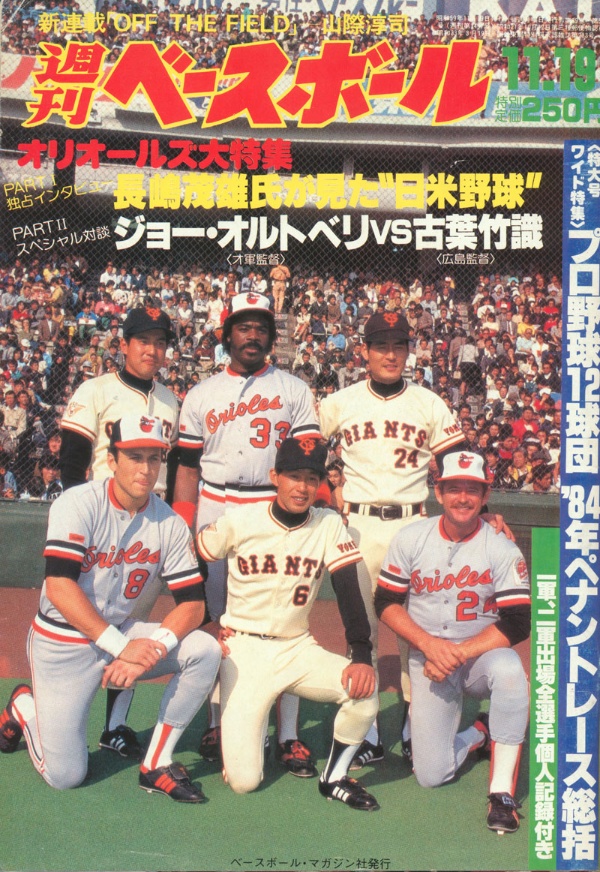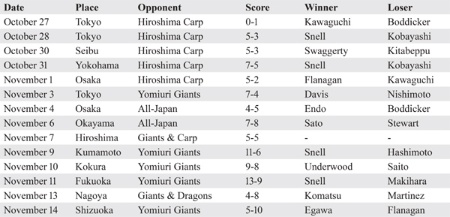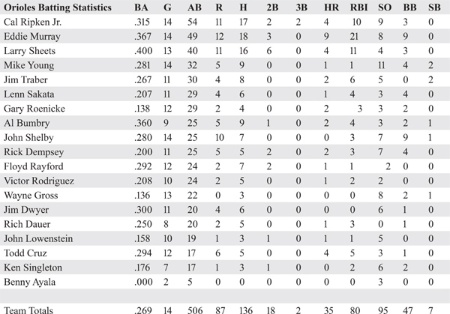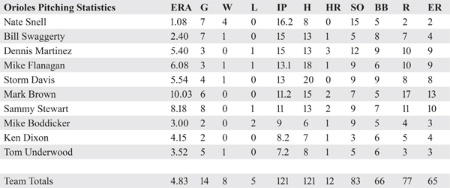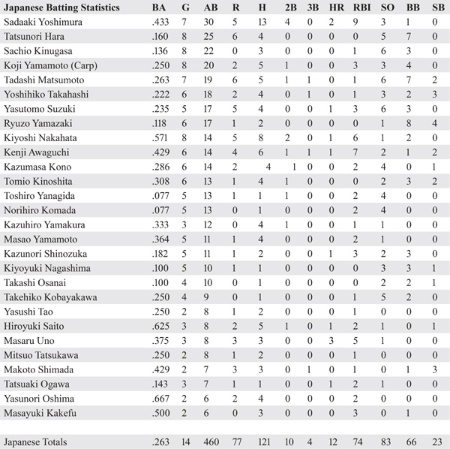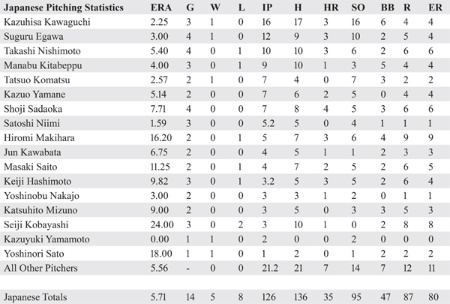The 1984 Baltimore Orioles Tour in Japan: The Final Attempt at a True World Series
This article was written by Carter Cromwell
This article was published in Nichibei Yakyu: US Tours of Japan, 1960-2019
November 19, 1984 issue of Shukan Baseball depicting stars of the Orioles and Yomiuri Giants (Robert Fitts Collection)
When the idea arose of a major-league team making a tour of Japan after the 1984 regular season, the grand vision – the hope – was that a true world series could finally take place.
It didn’t quite work out that way.
Ideally, the major-league representative would have been the Detroit Tigers, who outpaced all comers from Opening Day and easily won the World Series. But the logistics weren’t workable, so the 1983 champion Baltimore Orioles were invited. It was envisioned that the Yomiuri Giants – essentially, the New York Yankees of Japanese baseball and owned by the tour sponsor, Yomiuri Shimbun media group – would easily win the Japan Series, as they had so often done.
It didn’t quite work out that way.
In 1984 the Orioles slid from World Series champions to fifth place in their division. And the Giants – runners-up in the Japan Series in 1983 – finished third in the Central League and did not make the postseason.1
So the expectations were lowered, and the agenda was rewritten. Rather than two champions battling, the final schedule had the Orioles playing five games against the 1984 Japan Series champion Hiroshima Carp, five games against the Giants, two against a Japanese all-star team, and three against teams comprising players from two different clubs. The trip, spread over 22 days, coincided with the celebration of professional baseball’s 50th anniversary in Japan.
As one writer noted, “To many Japanese, it was if someone slipped in two glasses of Coke for the Pepsi Challenge.”2
Still, the Japanese always took very seriously opportunities to play against American teams. In the years since, Japan has proved its baseball capabilities, winning the first two World Baseball Classics and the Gold Medal at the 2020 Summer Olympics, but at the time the country was still striving to equal the United States, and fans were looking for any evidence that the Japanese game was catching up.
When Baltimore had its first practice after arriving in Japan, the Japanese press reported on how much power the Orioles displayed. Sadaharu Oh, the former Yomiuri Giants star, Japan’s all-time home-run leader (868), and by then the Giants’ manager, said of the Orioles, “We are going to learn more from them than they get from us. … They are 75 years ahead of us.”3
Many Japanese, though, including Nippon Professional Baseball Commissioner Takezo Shimoda, wondered if the gap was that yawning. While the Japanese didn’t have the power of the Americans, they felt that “like judo masters,” they “could turn the Americans’ strength against them.”4
And, indeed, Baltimore did not have a cakewalk. The Orioles went 8-5-1 overall: 4-1 versus Hiroshima and 4-1 against Yomiuri, but 0-3-1 against the combined teams and all-star teams. The Japanese had certainly improved since the last time Baltimore had come to Japan. The 1971 Orioles, a powerhouse club that had been upset by Pittsburgh in the World Series, toured Japan after that season and posted a 12-2-4 record. Those Orioles were 8-0-3 against the Giants – who had just won their seventh consecutive Japan Series title – including four shutouts and a no-hitter.5
It had been a month since the Orioles had completed their season, while the Carp had finished up their campaign just a week earlier with a victory over the Hankyu Braves in the Japan Series. It was hard to tell how seriously the Americans took the games. It was, after all, an exhibition tour, and a chance for the entourage to sightsee and experience Japan. And of course, the Orioles were getting paid – each player was to receive $22,500 (around $60,000 in 2022 dollars) plus expenses for his family.6
Players said pitchers did not want to risk arm injuries in games that meant nothing as far as a pennant chase went. First baseman Eddie Murray said, “You just come over here to enjoy yourself and try to play a good game of baseball.”7
Baltimore, though, did play five intrasquad games just before leaving home in an effort to stay sharp, and manager Joe Altobelli said, “It would be silly to come all the way over and not give them the best possible Baltimore Orioles.”8
The games began on October 27 at Korakuen Stadium, the home of the Yomiuri Giants from 1937 until 1988, when the Tokyo Dome opened next door. Korakuen Stadium was also, for various periods of time, home to seven other Japanese professional teams, and it housed the Japanese Baseball Hall of Fame until the advent of the Tokyo Dome.
Game 1 was all about Hiroshima left-hander Kazuhisa Kawaguchi. He had just completed his fourth season in NPB with a middling 8-6 record and a 4.23 earned-run average, but he looked like a world-beater against Baltimore. He went the distance, allowed just six hits, and drove in the only run of the game with a second-inning single off Orioles starter Mike Boddicker, who had won 20 games and made the American League All-Star team in 1984.
Baltimore had three scoring threats. They loaded the bases in the first inning on a single by Cal Ripken Jr., a walk to Eddie Murray, and an infield hit by Gary Roenicke, but couldn’t push across a run. John Shelby got as far as third base in the fifth inning, but he could get no farther, and in the seventh they had runners on first and second with no outs and failed to score. Asked what he thought of the Orioles’ hitters, Kawaguchi said, “I don’t know. They all looked alike to me.”9 The Carp got only three hits against Boddicker, Bill Swaggerty, and Sammy Stewart, but Kawaguchi made the difference.
“I want[ed] to see a home run,” said disappointed fan Harumi Michikawa, who was watching American baseball for the first time.10
Altobelli fell back on the tired-but-true cliché: “Good pitching will stop home runs every time. He’s a good kid, Kawaguchi.”11 “Our pitchers did very well,” Altobelli added. “Boddicker just got one ball up (against Kawaguchi). We’ll win tomorrow.”12
His prediction was on the mark.
Infielder Todd Cruz, who in 1984 had hit only three home runs in what turned out to be his last season in the major leagues, smacked two the next day and made a diving catch from his third-base spot to lead the Orioles to a 5-3 victory over the Carp. Cruz’s solo shots came in the seventh and ninth innings before a reported crowd of 45,000 in Korakuen Stadium.
Hiroshima jumped out to a 1-0 lead in the third, but Murray tied the game with an RBI single in the fourth inning. After Cruz homered, Hiroshima rallied with two seventh-inning runs to take a 3-2 lead, but Baltimore regained the lead in the top of the eighth when Murray and Ripken hit RBI singles. Storm Davis went five innings for the Orioles, allowing just one run, and Mark Brown, Tom Underwood, and Nate Snell finished up.
The atmosphere surrounding the second game was spiced by a flap between managers Altobelli and Takeshi Koba of Hiroshima. Japanese rules at the time required lineups to be exchanged by both managers at the same time 30 minutes prior to a game. Japanese managers would usually reveal their starting pitchers at this time, forcing opposing managers to guess whether their players would be facing a left-handed or right-handed starter. Unaware of this rule, Altobelli brought two lineups to home plate two minutes before the start of game 2 and handed the umpires his preferred lineup once he determined that Koba was starting right-handed Kazuo Yamane.
“You call this major league?” Koba asked after the game. “We are playing here. We should play by our rules.” Altobelli, who took responsibility for the mix-up before the second game, said simply, “In our minds, all managers think alike. He’s looking for any advantage he can get and I’m doing the same thing.”13
The Orioles gained the advantage, winning the next three games over Hiroshima by scores of 5-3, 7-5, and 5-2.
In Game 3 before just 15,000 fans on a cold, windy night at Seibu Stadium, the Carp scored on a first-inning sacrifice fly by Koji Yamamoto (an eventual Japanese Baseball Hall of Fame inductee) and a two-run home run off Ken Dixon in the fourth by outfielder Tatsuaki Ogawa. However, Larry Sheets helped the Orioles overcome the early deficit. His seventh-inning solo home run tied the game, 3-3, and the Orioles took the lead later in the inning when Ripken tripled and came on home on Murray’s sacrifice fly. In the next inning, Sheets doubled home Al Bumbry for an important insurance run.
Sheets, who had been called up late in the season after batting .302 at the Triple-A level, said the Japan series was “a proving time for me. Good play will give me a better chance to make the team next year.”14 His .400 average, 4 home runs, and 11 RBIs on the tour led to a long look in spring training of 1985 and an eventual eight-year big-league career.
The next night, October 31, before 20,000 fans in Yokohama Stadium, Baltimore again came from behind to win. The Orioles scored four times in the top of the ninth inning on a single by Jim Traber, a pinch-hit double by Ken Singleton, and a two-run single by Lenn Sakata. That rally came just after Hiroshima had scored twice in the bottom of the eighth inning on hits by Shinji Hara and Kiyoshi Yamanaka to take a short-lived 5-3 lead.
Hiroyuki Saito had given the Carp a 2-0 lead on a home run off Orioles starter Dennis Martinez. Sheets then doubled in a run in the third inning, and Sakata’s groundout in the fourth tied the score. Sheets hit another RBI double in the seventh inning, but Hiroshima tied the game in the bottom of the inning on a single by Yoshihiko Takahashi.15
A day later, 16,000 spectators in Osaka saw Murray drive in three runs with two home runs and Vic Rodriguez hit a two-run shot to lead Baltimore to a 5-2 victory and a 4-1 series win over Hiroshima. Kawaguchi was less successful than in his first outing, giving up three runs and eight hits in five innings. Mike Flanagan started for the Orioles and allowed four hits over five scoreless innings. Stewart earned his first save of the series. Altobelli said afterward that “[a]fter the loss in the first game, I thought it would be a little tough. But we played the best game of the series today.”16
The Orioles and Yomiuri Giants played the first of five games between the teams two days afterward, and Baltimore won, 7-4, on the strength of home runs by Murray, Ripken, and Sakata. Murray’s homer, a three-run shot, came in the first inning, and Ripken’s blast in the fifth gave the visitors a 5-1 advantage before 50,000 fans in Korakuen Stadium. Sakata homered in the sixth inning.
Davis allowed four runs and eight hits in his five innings, while Snell and Stewart combined to hold the Giants hitless in the final four innings. Yomiuri starter Takashi Nishimoto, who had posted a 15-11 record in the regular season, gave up five runs and seven hits in his five innings of work. Outfielder Sadaaki Yoshimura was 3-for-5 with an RBI for the Giants.17 (Yoshimura batted .433 in seven games during the tour.)
On November 4 Baltimore faced an all-star team made up of players from the 12 NPB teams and lost 5-4 as its three-run ninth-inning rally fell short. All-Japan scored single runs in each of the first three innings on a hit by Masayuki Kakefu of the Hanshin Tigers, a home run by Masaru Uno of the Chunichi Dragons, and another RBI single by Kakefu. Murray, who batted .367 with 9 home runs and 21 RBIs on the tour, homered in the seventh inning, but the all-stars scored twice in the eighth on run-scoring singles by Makoto Shimada of the Nippon Ham Fighters and Takayuki Kono of the Nankai Hawks. Baltimore got a two-run homer by Ripken and a solo shot from Murray in the ninth to get within a run, but reliever Kazuhiko Ushijima of the Dragons stopped the bleeding by striking out Sheets, Traber, and Singleton to end the game.18
All-Japan took another one-run victory two days later in Okayama, scoring six runs in the eighth inning to erase a 7-2 deficit and win 8-7. Stewart, who had saved four games earlier in the Orioles’ tour, didn’t have it this time. With two out in the eighth, he walked two batters to force in a run, allowed a two-run single to Masataka Nashida of the Kintetsu Buffaloes, and later gave up a three-run home run to Yomiuri second baseman Kazunori Shinozuka, who had led the Japanese Central League that season with a .334 batting average.19 Baltimore had gained its lead largely on the strength of three runs in the seventh and two in the eighth. Sheets hit a two-run homer in the seventh.20
The next game, played in a light drizzle before 16,000 fans in Hiroshima, featured Baltimore against a team comprising players from the Carp and the Giants. The game was called after nine innings and ended in a 5-5 tie. The Orioles scored twice in the first inning on Traber’s two-run homer, in the second on Gary Roenicke’s solo shot, and once in the fourth on Murray’s sixth homer of the series. Yoshimura hit a two-run homer in the third inning off Martinez and got another run in the fourth when third baseman Victor Rodriguez misplayed a groundball, allowing Kiyoyuki Nagashima to score from third base. Nagashima scored again in the sixth inning from third base when Orioles reliever Mark Brown dropped the ball while covering first base. Mitsuo Tatsukawa then hit a double to give the Japanese a 5-4 lead, but Traber hit his second home run of the game in the eighth to tie the score.21
Next, on November 9, the Orioles played the Giants again, this time in Kumamoto, and won 11-6, capitalizing on a 14-hit attack and four Yomiuri errors. Ripken, who batted .315 on the tour, was 4-for-5 with a home run, and Sheets, Cruz, and Rick Dempsey also homered. The Giants scored five runs in the fourth inning to take a 5-2 lead, but Baltimore rallied with six runs in the fifth as Dempsey, Ripken, and Cruz homered, and two more runs scored on a wild pickoff attempt.22
The teams traveled to Kokura, in southwestern Japan, for the next game. Playing before a crowd of 26,000, the Orioles held off a furious rally by Yomiuri to win 9-8. The Orioles jumped to a 4-0 lead after two innings – Rich Dauer’s two-run homer in the second was the highlight – and added five more in the fifth and sixth innings to lead, 9-3. Bumbry, a .360 hitter on the tour, homered in the fifth, and he and Floyd Rayford did the same in the sixth. The Giants nearly came all the way back, though, as Yasutomo Suzuki hit a two-run shot in the eighth inning and then two Baltimore errors in the ninth aided a three-run outburst that fell just short of tying the game. Though shaky, Swaggerty pitched the final two innings and managed to hold off the Giants, who outhit the Orioles 14 to 12.23
The same teams played again the next day before 31,000 in Kokura, and Baltimore had to again hold off a Yomiuri rally. Three-run homers by Murray and Sheets helped the visitors to a 9-0 lead after 4½ innings, but Yomiuri scored five times in the last half of the fourth, the big hit being a two-run home run by Kenji Awaguchi. The Orioles got a run in the fifth on Mike Young’s homer and then three more in the eighth to lead 13-5. The Giants, however, scored four runs in the eighth and ninth innings against Stewart to make the final score 13-9. Snell, the second Baltimore pitcher, picked up his fourth win of the tour. Giants starter Hiromi Makihara took the loss. Shelby, Sheets, and Murray combined for 10 RBIs, and Sheets went 4-for-5 at the plate.24
The next stop was Nagoya on November 13, where Baltimore played a team composed of players from the Dragons and Giants, who had finished second and third respectively in the Central League’s regular season. The Japanese team took a 5-1 lead after three innings, the big blow being a three-run homer in the third by Chunichi’s Masaru Uno. After Murray ripped a two-run shot in the sixth, Uno answered with a solo homer in the bottom of the inning. The Japanese scored twice more in the seventh, and Ripken homered for the Orioles in the eighth but it wasn’t enough as the Japanese won 8-4.25
A couple of days later, the Giants got a measure of revenge by defeating Baltimore 10-5 at Kusanagi Stadium in Shizuoka. Yomiuri scored all its runs in the fifth, sixth, and seventh innings. The Orioles held a 2-0 lead going into the bottom of the fifth. Coincidentally, just as Altobelli was telling a Japanese television interviewer that he was impressed with how the Japanese teams could create big innings, the Giants got to Flanagan, the Orioles starter. Yoshimura’s three-run home run was the highlight of a five-run outburst that got a laugh out of Singleton. “I’ll always remember Flanny for his sense of humor,” Singleton said. “I’ll never forget … when Altobelli went to the mound to ask [Flanagan] what was wrong, and he said, ‘That’s the problem with being on this side of the earth. My pitches go the other way.’”26
The Giants got three more runs in the sixth inning and then a two-run homer in the seventh by first baseman Kiyoshi Nakahata, who batted .571 in eight games during the tour. Cruz, Roenicke, and Murray all homered for Baltimore, but their efforts weren’t nearly enough, as the Orioles got only five hits off four Yomiuri pitchers.27
Baltimore was to play the next day in Kawasaki against a combination team of Lotte Orions and Yokohama Taiyo Whales players, but bad weather canceled the game and ended the tour.
Statistically, the Orioles played somewhat better than their hosts. They had a .269 team batting average to .263 for the Japanese. Baltimore had a huge 35-12 advantage in home runs, but outscored the Japanese only 87-77 over the 14 games. Murray hit nine home runs for the Orioles, tied for the third highest total for a player during a single tour; only Babe Ruth with 13 in 1934 and Hank Sauer with 12 in 1953 had hit more. (Johnny Bench also hit nine in 1978.) The Orioles’ 35 home runs topped their 1971 tour total by one but did not come close to surpassing the team totals for the 1934 All-Americans (47), the 1953 Eddie Lopat All-Stars (42), or the 1956 Brooklyn Dodgers (40).28
Singleton remembered the frustration Murray’s power display caused the Japanese pitchers. “Once we were playing in one of the old outdoor stadiums, and the opposing pitcher threw at Eddie’s head and knocked him down,” Singleton said. “Eddie got up, stared at the pitcher, and then ripped the next pitch. The fans all stood up, hoping someone would catch it, but it went completely out of the ballpark – 500-something feet.”
“He was deliberately slow rounding the bases; I bet he took 30 minutes to do it,” Singleton added with a laugh. “We were yelling at the Japanese pitcher to keep throwing at us.”29
Uno led the Japanese in home runs with three in the three games in which he played. Awaguchi batted .429 in 14 at-bats. Hiroshima third baseman Sachio Kinugasa, an eventual Japanese Hall of Famer, hit just .136 in eight games. Kinugasa later surpassed Lou Gehrig’s consecutive-games streak and finished with 2,215.30
On the pitching side, the Orioles posted a 4.83 earned-run average, while the Japanese had a 5.71 mark. Snell was the most impressive Orioles pitcher, going 4-0 with a 1.08 ERA. He had gone 1-1 with a 2.35 ERA in seven innings after a late-season call-up in 1984. Club officials had thought he was 29 years old, but when they arranged for his passport prior to the Japan trip, they discovered that he was 32.31 Nonetheless, he stuck with the Orioles in 1985 and went 3-2 with a 2.69 ERA, pitching 100 innings – all in relief. He then played two additional seasons in the majors.
Of the Japanese pitchers, 24-year-old Kazuhisa Kawaguchi had a 2.25 ERA in 16 innings over three games, and he struck out 16 batters. He went on to have an 18-season NPB career. Only two others – Suguru Egawa and Takashi Nishimoto, both of the Giants – pitched at least 10 innings. Egawa had a 3.00 ERA, and Nishimoto’s was 5.40. Two of the Japanese pitchers – Manabu Kitabeppu of Hiroshima and Masaki Saito of the Giants – later made the Japanese Baseball Hall of Fame. Kitabeppu, who had just completed the ninth of his eventual 19 NPB seasons, threw nine innings and posted a 4.00 ERA. Saito, who had just completed his rookie season, allowed seven hits and two walks in four innings and had an 11.25 ERA.
Inevitably, key topics of conversation were the differences between the US and Japanese styles of play and how well the Japanese matched up against the Americans. That is still true today, but it was even more so at that time, when fewer Americans were knowledgeable about Japanese baseball.
Orioles catcher Rick Dempsey noted the contrast between the small ball of the Japanese and the wait-for-the-big-inning Americans that still exists, saying, “The Japanese like to hit and run. They like to steal bases. They generally play a much more aggressive, a little quicker game than the Americans do.”32
As previous American players had learned, the umpires’ strike zone for foreign players can be much wider. As Sakata remarked, “If you’ve got a strike zone from your neck to the ground, it’s hard to hit.”33
Stan Isle explained in The Sporting News:
The Orioles’ exhibition tour of Japan provided some interesting contrasts in baseball technique. Ray Miller, Baltimore pitching coach, was surprised to learn that most Japanese pitchers throw hard every day and warm up much longer than their American counterparts. “The Japanese pitchers could throw a lot harder if they didn’t have them throwing 24 hours a day,” Miller said. He also noted that most Japanese pitchers have a hitch in the middle of their lengthy windups … [something major leaguers would discover 11 years later when Hideo Nomo debuted with the Los Angeles Dodgers]. Also, many Japanese hitters have hitches in their swings and lift their front feet in the manner of Sadaharu Oh. “They can get away with that stuff because the Japanese pitchers can’t throw hard enough,” said Ralph Rowe, Orioles batting instructor. Pitcher Sammy Stewart found Japanese hitters especially anxious to protect the plate on a two-strike count. “It’s like it’s a sin for them to strike out,” Stewart said, “but it’s OK to ground out.”34
Clyde Haberman of the New York Times noted, “Japanese teams spend many more hours in practice than the Americans are used to. Players carry their own bags and bats. The Japanese put far more emphasis on fundamentals. … Americans who insist that they know more about the game usually find their suggestions ignored, and sometimes scorned. The concept of team play almost always overrides individual considerations. Displays of temper and hurt, regarded by many American players as marks of desire and hustle, tend to be viewed by Japanese as selfish.”35
“A lot of guys get here thinking it will be easy [in Japan] hitting 30, 35 homers, batting .300,” said Tim Ireland, who played for the Carp in 1983 and ’84. “Then they find it’s a lot harder than they thought, and many just can’t deal with the Japanese way of doing things. I’ve gotten where I can tell in a few minutes whether someone is going to make it. … The biggest problem is communication. You’re isolated a lot of the time, with a language you don’t know and, for some families, it’s a style of living they can’t adjust to. In the States, if you’re a ballplayer, you’re just a commodity. But here you’re an imported commodity, and it’s worse.”36
In the wake of the tour, opinions seemed to be leaning slightly toward the sentiment that the Japanese game was getting better vis-à-vis the American game. After the first game, Altobelli commented, “Our team is superior in power and the Carp in speed. A trade between the two teams would make the best team.”37
Singleton, who had also played on the 1979 American League all-star team that toured Japan, said he wasn’t impressed with the Japanese pitchers at that time but “was more so when we went back there in 1984. They moved the ball around a lot and threw from different angles. And, certainly, they’ve had guys come over to the US since then and do well.”38
The mass-circulation newspaper Yomiuri Shimbun, whose conglomerate owns the Yomiuri Giants, wrote that “the Orioles’ win-loss record shows that Japanese players’ abilities are almost the same as American players, but it is still true that Japanese pro baseball is behind the US in terms of power and speed of its players.”39
The 31-year quest for an international world series by matching the Japanese and major league champions in an exhibition series had failed yet again. Beginning in 1953 Japanese organizers had tried to predict the World Series winner and invite that team to Japan. Although the predictions sometimes came close, a reigning World Series champion had never visited the Land of the Rising Sun. It was time for a change. The Orioles became the last major league club to face the Japanese champion in post-season exhibition series. The next time major leaguers visited Japan it would be under a new format.
CARTER CROMWELL is a former sportswriter for daily newspapers and a corporate public-relations professional. He works with an independent-league baseball team and contributes baseball-related articles to various websites. When not doing that, he has a passion for world travel, photography, and rescue dogs.
(Click images to enlarge)
Notes
1 Clyde Haberman, “World Series Loses Luster in Japan,” New York Times, October 31, 1984: B11..
2 Haberman.
3 John Burgess, “Orioles Look Anemic, Losing 1st to Carp, 1-0,” Washington Post, October 28, 1984: F3.
4 Burgess.
5 Burgess.
6 “Inflation Calculator,” Smartasset.com. https://smartasset.com/investing/inflation-calculator#OgTBeVEcQ8.
7 John Burgess, “Baseball in the Land of the Rising Sun,” Washington Post, November 17, 1984: C8.
8 Haberman.
9 Burgess, “Orioles Look Anemic, Losing 1st to Carp, 1-0.”
10 Burgess, “Orioles Look Anemic, Losing 1st to Carp, 1-0.”
11 Burgess, “Orioles Look Anemic, Losing 1st to Carp, 1-0.”
12 Associated Press, “Carp Edge Orioles 1-0 in First Game,” Japan Times, October 28, 1984: 11.
13 Jim Henneman, “Altobelli Spars With Japanese Pilot,” The Sporting News, November 12, 1984: 56.
14 Associated Press, “Sheets, Orioles Win 3rd,” Japan Times, October 31, 1984: 13.
15 Associated Press, “Sakata’s RBI Lifts Orioles to Series’ Win Over Carp,” Japan Times, November 1, 1984: 15.
16 Associated Press, “Orioles Cop Carp Series 4 Games to 1 With 5-2 Win,” Japan Times, November 2, 1984: 13.
17 Associated Press, “Orioles Blast 3 Homers, Whip Yomiuri Giants 7-4,” Japan Times, November 4, 1984: 11.
18 Associated Press, “All-Stars Rally Past Orioles 5-4 in Ninth,” Japan Times, November 6, 1984: 15.
19 Toshio Shinozuka changed his first name to Kazunori in 1992. As Baseball Reference.com refers to him by his later name, we will do so as well.
20 Associated Press, “All-Stars Romp Past Orioles 8-7,” Japan Times, November 7, 1984: 13.
21 Associated Press, “Baltimore Homers to Tie in Hiroshima,” Japan Times, November 8, 1984: 13.
22 Associated Press, “Orioles Whip Giants 11-6,” Japan Times, November 10, 1994: 13.
23 Associated Press, “Orioles Edge Giants 9-8 With 2 Homers,” Japan Times, November 11, 1984: 11.
24 Associated Press, “Orioles Win 4 in a Row, Beating Giants 13-9,” Japan Times, November 12, 1984: C3.
25 Associated Press, “Japanese Rally Orioles 8-4,” Japan Times, November 14, 1984: 15.
26 Bill Madden, “Mike Flanagan’s Suicide Leaves Former Baltimore Orioles Teammates, Friends Searching for Answers,” New York Daily News, August 26, 2011: 100.
27 Associated Press, “Yoshimura Lifts Giants to 10-5 Win Over Orioles,” Japan Times, November 15, 1984: 13.
28 Jim Henneman, “Boddicker Not Bitter on Cy Young,” The Sporting News, November 26, 1984: 56.
29 Ken Singleton, telephone interview, December 13, 2021.
30 https://www.baseball-reference.com/bullpen/Sachio_Kinugasa.
31 Jim Henneman, “Snell Comes Through in Japan,” The Sporting News, December 3, 1984: 49.
32 Burgess, “Baseball in the Land of the Rising Sun.”
33 Burgess, “Baseball in the Land of the Rising Sun.”
34 Stan Isle, “Phillies’ Frohwirth Is a Tekulve Clone,” The Sporting News, December 10, 1984: 9.
35 Haberman.
36 Haberman.
37 Associated Press, “Orioles Cop Carp Series 4 Games to 1 With 5-2 Win,” Japan Times, November 2, 1984: 13.
38 Singleton.
39 United Press International, “Orioles Wind Up Tour of Japan,” Japan Times, November 16, 1984: 13.
40 Listed Japanese players have a minimum of 5 at-bats, 3 innings pitched, or a decision. Yoshikazu Matsubayashi, Baseball Game History: Japan vs, U.S.A. (Tokyo: Baseball Magazine, 2004), 104; Nippon Professional Baseball Records, https://www.2689web.com/nb.html.


